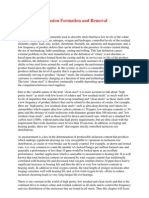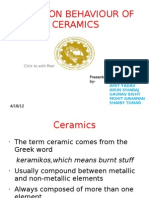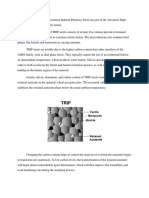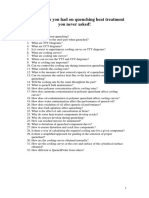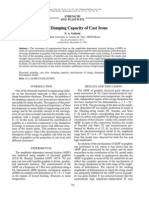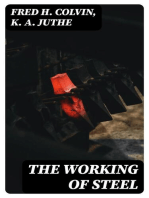Shape-Memory Alloy PDF
Shape-Memory Alloy PDF
Uploaded by
letter_ashish4444Copyright:
Available Formats
Shape-Memory Alloy PDF
Shape-Memory Alloy PDF
Uploaded by
letter_ashish4444Original Description:
Original Title
Copyright
Available Formats
Share this document
Did you find this document useful?
Is this content inappropriate?
Copyright:
Available Formats
Shape-Memory Alloy PDF
Shape-Memory Alloy PDF
Uploaded by
letter_ashish4444Copyright:
Available Formats
Shape-memory alloy
Shape-memory alloy
A shape-memory alloy (SMA, smart metal, memory metal, memory alloy, muscle wire, smart alloy) is an alloy that "remembers" its original, cold-forged shape: returning to the pre-deformed shape when heated. This material is a lightweight, solid-state alternative to conventional actuators such as hydraulic, pneumatic, and motor-based systems. Shape-memory alloys have applications in industries including medicine and aerospace.
Overview
The two main types of shape-memory alloys are copper-aluminium-nickel, and nickel-titanium (NiTi) alloys but SMAs can also be created by alloying zinc, copper, gold and iron. NiTi alloys are generally more expensive and change from austenite to martensite upon cooling; Mf is the temperature at which the transition to martensite completes upon cooling. Accordingly, during heating As and Af are the temperatures at which the transformation from martensite to austenite starts and finishes. Repeated use of the shape-memory effect may lead to a shift of the characteristic transformation temperatures (this effect is known as functional fatigue, as it is closely related with a change of microstructural and functional properties of the material).[1] The transition from the martensite phase to the austenite phase is only dependent on temperature and stress, not time, as most phase changes are, as there is no diffusion involved. Similarly, the austenite structure receives its name from steel alloys of a similar structure. It is the reversible diffusionless transition between these two phases that results in special properties. While martensite can be formed from austenite by rapidly cooling carbon-steel, this process is not reversible, so steel does not have shape-memory properties.
In this figure, (T) represents the martensite fraction. The difference between the heating transition and the cooling transition gives rise to hysteresis where some of the mechanical energy is lost in the process. The shape of the curve depends on the material properties of the shape-memory alloy, such as the alloying.[2] and work hardening.[3]
Shape-memory alloy
One-way vs. two-way shape memory
Shape-memory alloys have different shape-memory effects. Two common effects are one-way and two-way shape memory. A schematic of the effects is shown below.
The procedures are very similar: starting from martensite (a), adding a reversible deformation for the one-way effect or severe deformation with an irreversible amount for the two-way (b), heating the sample (c) and cooling it again (d).
One-way memory effect
When a shape-memory alloy is in its cold state (below As), the metal can be bent or stretched and will hold those shapes until heated above the transition temperature. Upon heating, the shape changes to its original. When the metal cools again it will remain in the hot shape, until deformed again. With the one-way effect, cooling from high temperatures does not cause a macroscopic shape change. A deformation is necessary to create the low-temperature shape. On heating, transformation starts at As and is completed at Af (typically 2 to 20 C or hotter, depending on the alloy or the loading conditions). As is determined by the alloy type and composition and can vary between 150C and 200C.
Two-way memory effect
The two-way shape-memory effect is the effect that the material remembers two different shapes: one at low temperatures, and one at the high-temperature shape. A material that shows a shape-memory effect during both heating and cooling is called two-way shape memory. This can also be obtained without the application of an external force (intrinsic two-way effect). The reason the material behaves so differently in these situations lies in training. Training implies that a shape memory can "learn" to behave in a certain way. Under normal circumstances, a shape-memory alloy "remembers" its low-temperature shape, but upon heating to recover the high-temperature shape, immediately "forgets" the low-temperature shape. However, it can be "trained" to "remember" to leave some reminders of the deformed low-temperature condition in the high-temperature phases. There are several ways of doing this.[4] A shaped, trained object heated beyond a certain point will lose the two-way memory effect, this is known as "amnesia".
Shape-memory alloy
Pseudo-elasticity
One of the commercial uses of shape-memory alloy exploits the pseudo-elastic properties of the metal during the high-temperature (austenitic) phase. The frames of reading glasses have been made of shape-memory alloy as they can undergo large deformations in their high-temperature state and then instantly revert to their original shape when the stress is removed. This is the result of pseudoelasticity; the martensitic phase is generated by stressing the metal in the austenitic state and this martensite phase is capable of large strains. With the removal of the load, the martensite transforms back into the austenite phase and resumes its original shape. This allows the metal to be bent, twisted and pulled, before reforming its shape when released. This means the frames of shape-memory alloy glasses are claimed to be "nearly indestructible" because it appears no amount of bending results in permanent plastic deformation. The martensite temperature of shape-memory alloys is dependent on a number of factors including alloy chemistry. Shape-memory alloys with transformation temperatures in the range of 601450 K have been made.
History
The first reported steps towards the discovery of the shape-memory effect were taken in the 1930s. According to Otsuka and Wayman, A. lander discovered the pseudoelastic behavior of the Au-Cd alloy in 1932. Greninger and Mooradian (1938) observed the formation and disappearance of a martensitic phase by decreasing and increasing the temperature of a Cu-Zn alloy. The basic phenomenon of the memory effect governed by the thermoelastic behavior of the martensite phase was widely reported a decade later by Kurdjumov and Khandros (1949) and also by Chang and Read (1951).[1] The nickel-titanium alloys were first developed in 19621963 by the United States Naval Ordnance Laboratory and commercialized under the trade name Nitinol (an acronym for Nickel Titanium Naval Ordnance Laboratories). Their remarkable properties were discovered by accident. A sample that was bent out of shape many times was presented at a laboratory management meeting. One of the associate technical directors, Dr. David S. Muzzey, decided to see what would happen if the sample was subjected to heat and held his pipe lighter underneath it. To everyone's amazement the sample stretched back to its original shape.[5][6] There is another type of SMA, called a ferromagnetic shape-memory alloy (FSMA), that changes shape under strong magnetic fields. These materials are of particular interest as the magnetic response tends to be faster and more efficient than temperature-induced responses. Metal alloys are not the only thermally-responsive materials; shape-memory polymers have also been developed, and became commercially available in the late 1990s.
Crystal structures
Many metals have several different crystal structures at the same composition, but most metals do not show this shape-memory effect. The special property that allows shape-memory alloys to revert to their original shape after heating is that their crystal transformation is fully reversible. In most crystal transformations, the atoms in the structure will travel through the metal by diffusion, changing the composition locally, even though the metal as a whole is made of the same atoms. A reversible transformation does not involve this diffusion of atoms, instead all the atoms shift at the same time to form a new structure, much in the way a parallelogram can be made out of a square by pushing on two opposing sides. At different temperatures, different structures are preferred and when the structure is cooled through the transition temperature, the martensitic structure forms from the austenitic phase.
Shape-memory alloy
Manufacture
Shape-memory alloys are typically made by casting, using vacuum arc melting or induction melting. These are specialist techniques used to keep impurities in the alloy to a minimum and ensure the metals are well mixed. The ingot is then hot rolled into longer sections and then drawn to turn it into wire. The way in which the alloys are "trained" depends on the properties wanted. The "training" dictates the shape that the alloy will remember when it is heated. This occurs by heating the alloy so that the dislocations re-order into stable positions, but not so hot that the material recrystallizes. They are heated to between 400C and 500C for 30 minutes. They are then shaped while hot and are cooled rapidly by quenching in water or by cooling with air.
Properties
The copper-based and NiTi-based shape-memory alloys are considered to be engineering materials. These compositions can be manufactured to almost any shape and size. The yield strength of shape-memory alloys is lower than that of conventional steel, but some compositions have a higher yield strength than plastic or aluminum. The yield stress for Ni Ti can reach 500MPa. The high cost of the metal itself and the processing requirements make it difficult and expensive to implement SMAs into a design. As a result, these materials are used in applications where the super elastic properties or the shape-memory effect can be exploited. The most common application is in actuation. One of the advantages to using shape-memory alloys is the high level of recoverable plastic strain that can be induced. The maximum recoverable strain these materials can hold without permanent damage is up to 8% for some alloys. This compares with a maximum strain 0.5% for conventional steels.
Practical limitations
SMA have many advantages over traditional actuators, but do suffer from a series of limitations that may impede practical application.
Response time and response symmetry
SMA actuators are typically actuated electrically, where an electric current results in Joule heating. Deactivation typically occurs by free convective heat transfer to the ambient environment. Consequently, SMA actuation is typically asymmetric, with a relatively fast actuation time and a slow deactuation time. A number of methods have been proposed to reduce SMA deactivation time, including forced convection, and lagging the SMA with a conductive material in order to manipulate the heat transfer rate. Novel methods to enhance the feasibility of SMA actuators include the use of a conductive "lagging". this method uses a thermal paste to rapidly transfer heat from the SMA by conduction. This heat is then more readily transferred to the environment by convection as the outer radii (and heat transfer area) is significantly greater than for the bare wire. This method results in a significant reduction in deactivation time and a symmetric activation profile. As a consequence of the increased heat transfer rate, the required current to achieve a given actuation force is increased.[7]
Shape-memory alloy
Comparative force-time response of bare and lagged Ni-Ti shape memory alloy.
[8]
Structural fatigue and functional fatigue
SMA is subject to structural fatigue a failure mode by which cyclic loading results in the initiation and propagation of a crack that eventually results in catastrophic loss of function by fracture. The physics behind this fatigue mode is accumulation of microstructural damage during cyclic loading. In addition to this failure mode, which is not exclusively observed in smart materials, SMA are also subject to functional fatigue, whereby the SMA does not fail structurally, but, due to a combination of applied stress, and/or temperature, loses its ability to undergo a reversible phase transformation. For example, the working displacement in an actuator decreases with increasing cycle numbers. The physics behind this is gradual change in microstructure.
Unintended actuation
SMA actuators are typically actuated electrically by Joule heating. If the SMA is used in an environment where the ambient temperature is uncontrolled, unintentional actuation by ambient heating may occur.
Applications
Industrial
Aircraft Boeing, General Electric Aircraft Engines, Goodrich Corporation, NASA, and All Nippon Airways developed the Variable Geometry Chevron using shape-memory alloy that reduces aircraft's engine noise. Piping The first consumer commercial application for the material was as a shape-memory coupling for piping, e.g. oil line pipes for industrial applications, water pipes and similar types of piping for consumer/commercial applications. Automotive The first high volume product (> 5Mio actuators / annual) is an automotive valve application build to run low pressure pneumatics /bladders in a car seat to adjust the contour (lumbar support / bolsters). The accounting of basical all benefits of SMA over solenoids (noise/EMC/weight/package (form factor)/power consumption) was the crucial factor to replace the standard technology by SMA. Where in other applications usually just 2 or 3 SMA benefits are considered and hinder from replacing the 'old' technologies.
Shape-memory alloy Telecommunication The second high volume application was an autofocus (AF) actuator for a smart phone. There are currently several companies working on an optical image stabilisation (OIS) module driven by SMA wires.[citation needed] Robotics There have also been limited studies on using these materials in robotics, for example the hobbyist robot Stiquito (and "Roboterfrau Lara"[9]), as they make it possible to create very light robots. Weak points of the technology are energy inefficiency, slow response times, and large hysteresis.
Medicine
Shape-memory alloys are applied in medicine, for example, as fixation devices for osteotomies in orthopaedic surgery, in dental braces to exert constant tooth-moving forces on the teeth. The late 1980s saw the commercial introduction of Nitinol as an enabling technology in a number of minimally invasive endovascular medical applications. While more costly than stainless steel, the self expanding properties of Nitinol alloys manufactured to BTR (Body Temperature Response), have provided an attractive alternative to balloon expandable devices in stent grafts where it gives the ability to adapt to the shape of certain blood vessels when exposed to body temperature. On average, 50% of all peripheral vascular stents currently available on the worldwide market are manufactured with Nitinol. Optometry Eyeglass frames made from titanium-containing SMAs are marketed under the trademarks Flexon and TITANflex. These frames are usually made out of shape-memory alloys that have their transition temperature set below the expected room temperature. This allows the frames to undergo large deformation under stress, yet regain their intended shape once the metal is unloaded again. The very large apparently elastic strains are due to the stress-induced martensitic effect, where the crystal structure can transform under loading, allowing the shape to change temporarily under load. This means that eyeglasses made of shape-memory alloys are more robust against being accidentally damaged. Orthopedic surgery Memory metal has been utilized in orthopedic surgery as a fixation-compression device for osteotomies, typically for lower extremity procedures. The device, usually in the form of a large staple, is stored in a refrigerator in its malleable form and is implanted into pre-drilled holes in the bone across an osteotomy. As the staple warms it returns to its non-malleable state and compresses the bony surfaces together to promote bone union.[10] Dentistry The range of applications for SMAs has grown over the years, a major area of development being dentistry. One example is the prevalence of dental braces using SMA technology to exert constant tooth-moving forces on the teeth; the nitinol archwire was developed in 1972 by orthodontist George Andreasen.[11] This revolutionized clinical orthodontics. Andreasen's alloy has a patterned shape memory, expanding and contracting within given temperature ranges because of its geometric programming. Harmeet D. Walia later utilized the alloy in the manufacture of root canal files for endodontics.
Shape-memory alloy
Engines
Experimental solid state heat engines, operating from the relatively small temperature differences in cold and hot water reservoirs, have been developed since the 1970s, including the Banks Engine, developed by Ridgway Banks.
Materials
Alloys of metals having the memory effect at different temperatures and at different percentages of its solid solution contents.New materials are alloyed into shape memory alloy to change the Ms, MfAs, Af. These new alloy gives designer a large degree of freedom to match the situation in different situations. Shape memory alloys can be classified into variety of categories: primary element, mode of actuation, operation temperature or desired behavior. Ag-Cd 44/49 at.% Cd Au-Cd 46.5/50 at.% Cd Cu-Al-Ni 14/14.5 wt.% Al and 3/4.5 wt.% Ni Cu-Sn approx. 15 at.% Sn Cu-Zn 38.5/41.5 wt.% Zn Cu-Zn-X (X = Si, Al, Sn) Fe-Pt approx. 25 at.% Pt Mn-Cu 5/35 at.% Cu Fe-Mn-Si Pt alloys Co-Ni-Al Co-Ni-Ga Ni-Fe-Ga Ti-Pd in various concentrations Ni-Ti (~55% Ni) Ni-Ti-Nb Ni-Mn-Ga
References
[1] Shape Memory Materials (http:/ / catdir. loc. gov/ catdir/ samples/ cam034/ 97036119. pdf), K Otsuka, CM Wayman, Cambridge University Press, 1999 ISBN 0-521-66384-9 [4] Shape Memory Alloy Shape Training Tutorial (http:/ / www-personal. umich. edu/ ~btrease/ share/ SMA-Shape-Training-Tutorial. pdf). (PDF) . Retrieved on 2011-12-04. [5] Kauffman, George, and Isaac Mayo. "Memory Metal." Chem Matters Oct. 1993: 47. [6] Oral history by William J. Buehler (http:/ / www. wolaa. org/ files/ Nitinol_Oral_History. pdf). (PDF) . Retrieved on 2011-12-04. [9] The Lara Project G1 and G2 (http:/ / www. lararobot. de). Lararobot.de. Retrieved on 2011-12-04. [11] obituary of Dr. Andreasen (http:/ / query. nytimes. com/ gst/ fullpage. html?res=950DE2D7153EF936A2575BC0A96F948260). New York Times (1989-08-15). Retrieved on 2011-12-04.
Shape-memory alloy
External links
Shape Memory Alloys and Their Applications (http://www.stanford.edu/~richlin1/sma/sma.html) Introductory information on shape-memory alloys Lagging for control of shape memory alloy actuator response time (http://www.sciencedirect.com/science/ article/pii/S0261306909005524) Materials & Design, M. Leary, F. Schiavone, A. Subic Optimisation of NiTi shape memory alloy response time by transient heat transfer analysis (http://www. sciencedirect.com/science/article/pii/S0261306911006686) Materials & Design, S. Huang, M.Leary, T.Ataalla, K.Probst, A.Subic Nitinol Technical Information (http://jmmedical.com/resources.html) (from Johnson Matthey, Inc.) BBC report on medical applications of Nitinol (http://news.bbc.co.uk/1/hi/health/755819.stm) SFB 459: A German research center for shape-memory alloys (http://www.ruhr-uni-bochum.de/sfb459/ english/) A German company that develops and produce SMA-Materials (http://www.ingpuls.de/) SMAterial.com phenomena, crystallography, model, simulation and applications of SMA (http://www. smaterial.com) Has .gif animations demonstrating the effect. Main site for the Consortium for the Advancement of SMA Research and Technology (http://casmart.tamu. edu) Introduction to government, academic, and industrial research partners. Texas A&M University's Shape Memory Alloy Research Team (http://smart.tamu.edu) SMA overview, publications, etc. Institute of Physics, ASCR (http://www.fzu.cz/departments/metals/sma/) Research Projects, publications, events & conferences, functional materials SMST Proceedings (http://web.archive.org/web/20030810230928/www.sma-inc.com/education.html) Fundamentals and applications of shape memory alloys (http://www.materialforschungsservice-dr-prieb.de/ Publikationen.htm) (German) DoITPoMS Teaching and Learning Package: "Superelasticity and Shape Memory Alloys" (http://www. doitpoms.ac.uk/tlplib/superelasticity/index.php)
Article Sources and Contributors
Article Sources and Contributors
Shape-memory alloy Source: https://en.wikipedia.org/w/index.php?oldid=558602801 Contributors: 04walkc, 0x0077BE, 1ForTheMoney, 2, 2601:D:8040:A:838:1825:4E09:11DA, 2over0, 4CHANIAN, 7, A8UDI, ABF, AKMask, Aafilms4, Abrech, Ahoerstemeier, Alistair1978, Amoredios, Andyjsmith, Anuran, Anyep, Archiemartin, Arun.biomedical, Asadjadpour, Average Earthman, Bean114, Beetstra, BenFrantzDale, Benjah-bmm27, Bility, Bill1239, Bill37212, Blue520, Bobo192, Brech, Bryan Duggan, Buchanan-Hermit, Can't sleep, clown will eat me, CaptainVindaloo, Challiyan, Chochopk, Chrisgross, Chriswiki, Cje, Clemwang, Codetiger, Cometstyles, CommonsDelinker, ConradPino, Courcelles, D, David spector, Decarcique, Deewhite, Dispenser, Donfbreed, Dougher, Dragon of the Rust, DragonflySixtyseven, EJF, Ello uk2, Epbr123, Excirial, FastLizard4, Ferengi, Fongs, Fox Wilson, Frankenpuppy, FreeKresge, FuegoFish, Gareth Griffith-Jones, Geronimo60, Gimboid13, Gogo Dodo, Graham87, Griffinberger, Gtpod, Gveret Tered, Gwernol, Haikupoet, Hammer Raccoon, Hanina, Headbomb, Heron, HoodedMan, Hothghuma, Hypnotism123, Iqmanuelnavarro, J.delanoy, Jamessugrono, Japanese Searobin, Jayaram dadda, JdwNYC, Jessicapierce, Jhinman, Jkl, Jmkim dot com, Jmlk17, Jtranzen, JustAGal, Jwsadler, Kateshortforbob, Keenan Pepper, Keilana, KitSolidor, Koepmar, Kourang, Krawi, Krj373, Kwamikagami, Lab-oratory, Laika76, Laleena, Laogooli, Lightmouse, Lights, LoOkLeFt, LochVoil, Madlobster, Makotti, Materialscientist, Matt.Young.WI, Matthew Firestone, Maximus Rex, Meisam, Meiskam, Mercurywoodrose, Micha Sobkowski, Mikael Hggstrm, Mild Bill Hiccup, Mindmaker, Mr t is cool, Msrbl49, NHRHS2010, Naveenmecha, Neutrality, Ngebbett, Nihiltres, NorwegianBlue, NuclearWarfare, Oda Mari, OlEnglish, Olamideakosile, OllieFury, Ollythewally1, Omicronpersei8, Onorem, Orange Suede Sofa, Pakaraki, Paultt, Pdgallac, PeterLewis8663, Philip Trueman, Piano non troppo, Pinethicket, Pinhead69, Platypusx, Pratyya Ghosh, Pretzelpaws, Pwhitey86, Reach Out to the Truth, Res2216firestar, Rich Farmbrough, Rickky678, RobertMfromLI, Robertwharvey, Rock4p, Rossami, Routy, SMA, Sbandrews, Shaddack, Shadowjams, Shervinemami, Shirulashem, Signalizing, SiobhanHansa, SkyLined, SomeStranger, SpaceFlight89, Spudlz, Squids and Chips, Ssr, Stephenb, Still, Swalo 2k8, Tangwenli, Tanthalas39, Tanvir Ahmmed, Taw, TechTube, Thakorsagar93, The wub, Tohd8BohaithuGh1, TonyHagale, Toohool, Trainik, TreacherousWays, Tslocum, Tyw7, Utcursch, Vanished user vjhsduheuiui4t5hjri, Versus22, WereSpielChequers, Wikicheng, Wikieditor06, Wizard191, Wolfmankurd, Wuhwuzdat, Xanzzibar, Xyphy, Yintan, Youarefunny, 624 anonymous edits
Image Sources, Licenses and Contributors
File:Sma wire.jpg Source: https://en.wikipedia.org/w/index.php?title=File:Sma_wire.jpg License: Creative Commons Attribution-ShareAlike 3.0 Unported Contributors: Bkell, Maksim, Nachcommonsverschieber, Pieter Kuiper File:SMAoneway.jpg Source: https://en.wikipedia.org/w/index.php?title=File:SMAoneway.jpg License: Creative Commons Attribution-Sharealike 2.5 Contributors: Fongs, Mikhail Ryazanov, WikipediaMaster File:SMAtwoway.jpg Source: https://en.wikipedia.org/w/index.php?title=File:SMAtwoway.jpg License: Creative Commons Attribution-Sharealike 2.5 Contributors: Fongs, WikipediaMaster File:Comparative force-time response of bare and lagged Ni-Ti shape memory alloy.png Source: https://en.wikipedia.org/w/index.php?title=File:Comparative_force-time_response_of_bare_and_lagged_Ni-Ti_shape_memory_alloy.png License: Creative Commons Attribution-Sharealike 3.0 Contributors: Laika76
License
Creative Commons Attribution-Share Alike 3.0 Unported //creativecommons.org/licenses/by-sa/3.0/
You might also like
- BS en 1873-2014Document82 pagesBS en 1873-2014desenvolvimento100% (1)
- Fe Fe3c Diagram PDFDocument2 pagesFe Fe3c Diagram PDFAmyNo ratings yet
- InclusionsDocument40 pagesInclusionsricha_msmeNo ratings yet
- Wire DrawingDocument18 pagesWire DrawingstaniNo ratings yet
- Defects and Defect Processes in Nonmetallic SolidsFrom EverandDefects and Defect Processes in Nonmetallic SolidsRating: 4 out of 5 stars4/5 (1)
- Atmosphere FoldableDocument3 pagesAtmosphere Foldableletter_ashish4444No ratings yet
- Shape Memory Alloys 160216153820Document25 pagesShape Memory Alloys 160216153820lakku12No ratings yet
- Smart MaterialsDocument17 pagesSmart MaterialsABDUL SHAFI MNo ratings yet
- Amorphous MetalDocument5 pagesAmorphous MetalTeka KamNo ratings yet
- Bme Project ReportDocument16 pagesBme Project ReportAditya RanjanNo ratings yet
- Group 1: Dexter Alicaway Kevin ArriesgadoDocument19 pagesGroup 1: Dexter Alicaway Kevin ArriesgadoBenz Andrew RegisNo ratings yet
- Metallic GlassDocument19 pagesMetallic GlassHarmish BhattNo ratings yet
- Shape Memory AlloyDocument22 pagesShape Memory AlloyCSETUBENo ratings yet
- Review of Magnesium Metal Matrix CompositesDocument19 pagesReview of Magnesium Metal Matrix CompositesGokulraju RangasamyNo ratings yet
- A Comparative Study of The Forming-Limit Diagram Next Term Models For Sheet SteelsDocument8 pagesA Comparative Study of The Forming-Limit Diagram Next Term Models For Sheet SteelsRaghav KhajuriaNo ratings yet
- Friction of CeramicsDocument37 pagesFriction of CeramicsChandrika LakhanpalNo ratings yet
- Bio Materials 12006Document20 pagesBio Materials 12006Salvador ButlerNo ratings yet
- TRIP SteelsDocument2 pagesTRIP Steelschristofer kevinNo ratings yet
- Diamond Like Amorphous Carbon PDFDocument153 pagesDiamond Like Amorphous Carbon PDFமாத்தி யோசிப்பேன்No ratings yet
- Heat Treatment by Quenching - DiagramsDocument20 pagesHeat Treatment by Quenching - Diagramssunilmathew4477No ratings yet
- Fundamentals of Metal Forming ProcessesDocument23 pagesFundamentals of Metal Forming ProcessesVinayak Bhustalimath50% (2)
- Joining ProcessesDocument10 pagesJoining ProcessesSachin KhotNo ratings yet
- Cast Iron DampingDocument5 pagesCast Iron Dampinggabs88No ratings yet
- Alnico Magnets: Types Features Applications Manufacturing Process Magnetizing Graphical Representation PropertiesDocument18 pagesAlnico Magnets: Types Features Applications Manufacturing Process Magnetizing Graphical Representation PropertiesparthpatelparthNo ratings yet
- Machining of Magnesium AlloyDocument47 pagesMachining of Magnesium AlloyIon BadoiNo ratings yet
- Magnesium Alloys and Titanium and Its Heat TreatmentDocument16 pagesMagnesium Alloys and Titanium and Its Heat TreatmentNelson AlvarezNo ratings yet
- Ijsetr Vol 3 Issue 10 2868 2872Document5 pagesIjsetr Vol 3 Issue 10 2868 2872Deva IsmayaNo ratings yet
- A Computational Model For The Prediction of Steel HardenabilityDocument12 pagesA Computational Model For The Prediction of Steel HardenabilityfdcarazoNo ratings yet
- Segregation and Banding in Carbon and Alloy Steel - 2013-10-07 - Industrial HeatingDocument3 pagesSegregation and Banding in Carbon and Alloy Steel - 2013-10-07 - Industrial HeatingharieduidNo ratings yet
- Engineering Materials and Mettlurgy QBDocument12 pagesEngineering Materials and Mettlurgy QBSaravana KumarNo ratings yet
- RMW3 20 Harata TDocument18 pagesRMW3 20 Harata TmaghfiraNo ratings yet
- Advances in The Metallurgy and Applications of ADIDocument18 pagesAdvances in The Metallurgy and Applications of ADISEP-PublisherNo ratings yet
- Aluminium Alloy Applications PDFDocument3 pagesAluminium Alloy Applications PDFKhanHasibKaisarNo ratings yet
- Phase Field Modelling of Martensitic TransformationsDocument4 pagesPhase Field Modelling of Martensitic Transformationsharish_158No ratings yet
- ME 292 - Metallic Materials SessionalDocument39 pagesME 292 - Metallic Materials SessionalMuhammedNayeemNo ratings yet
- Effect of Microstructure and Alloy Contents On The Luders Line Formation in Al-Mg AlloysDocument6 pagesEffect of Microstructure and Alloy Contents On The Luders Line Formation in Al-Mg AlloysJinsoo KimNo ratings yet
- CleanSteel9 2015 CAPURRO PDFDocument11 pagesCleanSteel9 2015 CAPURRO PDFSpark Fernando Calderon ContrerasNo ratings yet
- Attachment Gas DynamisDocument2 pagesAttachment Gas DynamisArif Abdul RahmanNo ratings yet
- Effect of Cooling Rate On Microstructure and Mechanical Properties of Gray Cast Iron - IsIDocument6 pagesEffect of Cooling Rate On Microstructure and Mechanical Properties of Gray Cast Iron - IsIgiokniessNo ratings yet
- Lead and Lead Alloys - Properties and TechnologyDocument565 pagesLead and Lead Alloys - Properties and TechnologyqcNo ratings yet
- Materials Science C14: Polymer Processing: Natural Sciences Tripos Part IIDocument46 pagesMaterials Science C14: Polymer Processing: Natural Sciences Tripos Part IIjameswood20No ratings yet
- Magnetic MaterialsDocument18 pagesMagnetic MaterialsAmitKumarNo ratings yet
- Master AlloysDocument8 pagesMaster AlloysAsif AliNo ratings yet
- I - Internal Question Paper GDJPDocument2 pagesI - Internal Question Paper GDJPSam VelNo ratings yet
- 1.0 TitleDocument10 pages1.0 TitlezackziffiNo ratings yet
- Schematically Shows The Open and Cross Belt Drive Quick Return Quick Return Mechanism of A PlanerDocument6 pagesSchematically Shows The Open and Cross Belt Drive Quick Return Quick Return Mechanism of A Planeranilm130484meNo ratings yet
- Lead-Tin Phase EquilibirumDocument19 pagesLead-Tin Phase Equilibirummenonharsh91% (11)
- 2019-High Cycle Fatigue Behavior of Hard Turned 300 M Ultra-High Strength SteelDocument12 pages2019-High Cycle Fatigue Behavior of Hard Turned 300 M Ultra-High Strength SteelYoussef Mbarek100% (1)
- Magnesium-Alloy Sheet and Plate: Standard Specification ForDocument6 pagesMagnesium-Alloy Sheet and Plate: Standard Specification ForDanZel DanNo ratings yet
- Metal Matrix CompositesDocument30 pagesMetal Matrix CompositesRoger LaraNo ratings yet
- Texture Evolution in Grain-Oriented Electrical Steel During Hot Band Annealing and Cold RollingDocument10 pagesTexture Evolution in Grain-Oriented Electrical Steel During Hot Band Annealing and Cold Rollingد. علا محمد حداويNo ratings yet
- Functionally Graded MaterialsDocument16 pagesFunctionally Graded MaterialsPradeepkumar Chikkamath100% (1)
- Iron Carbon Phase DiagramDocument3 pagesIron Carbon Phase DiagramrabikmNo ratings yet
- Unit V Powder Metallurgy and Plastic MoldingDocument48 pagesUnit V Powder Metallurgy and Plastic MoldingGayatri KanwadeNo ratings yet
- ShaperDocument20 pagesShaperMilan SainiNo ratings yet
- Cleaness Steel CastingDocument61 pagesCleaness Steel CastingSUNDRAMNAGANo ratings yet
- Microsoft PowerPoint - Austenitic Manganese Steel Compatibility Mode 2Document81 pagesMicrosoft PowerPoint - Austenitic Manganese Steel Compatibility Mode 2Damla Kaymakçı100% (1)
- Damage Mechanics in Metal Forming: Advanced Modeling and Numerical SimulationFrom EverandDamage Mechanics in Metal Forming: Advanced Modeling and Numerical SimulationRating: 4 out of 5 stars4/5 (1)
- The Working of Steel: Annealing, Heat Treating and Hardening of Carbon and Alloy SteelFrom EverandThe Working of Steel: Annealing, Heat Treating and Hardening of Carbon and Alloy SteelNo ratings yet
- Shape Memory AlloyDocument8 pagesShape Memory Alloypepe_nabasNo ratings yet
- Python HistoryDocument3 pagesPython Historyletter_ashish4444No ratings yet
- 10 Viscoelasticity 04 Hereditaory PDFDocument12 pages10 Viscoelasticity 04 Hereditaory PDFletter_ashish4444No ratings yet
- Von Mises Yield CriterionDocument4 pagesVon Mises Yield Criterionletter_ashish4444No ratings yet
- Ceramic: For Other Uses, See - A Ceramic Is An, NonmetallicDocument7 pagesCeramic: For Other Uses, See - A Ceramic Is An, Nonmetallicletter_ashish4444No ratings yet
- Tensile TestingDocument4 pagesTensile Testingletter_ashish4444No ratings yet
- NP ChartDocument2 pagesNP Chartletter_ashish4444No ratings yet
- Composite Material PDFDocument10 pagesComposite Material PDFjaviercdeaeNo ratings yet
- Ansys Quick TipsDocument12 pagesAnsys Quick Tipsletter_ashish4444100% (1)
- Anti-Lock Braking SystemDocument7 pagesAnti-Lock Braking Systemletter_ashish4444No ratings yet
- Definitions of Financial ManagementDocument2 pagesDefinitions of Financial Managementletter_ashish4444No ratings yet
- Hamilton's PrincipleDocument8 pagesHamilton's Principleletter_ashish4444No ratings yet
- Predictor-Corrector MethodDocument3 pagesPredictor-Corrector Methodletter_ashish4444No ratings yet
- Trade SecretDocument9 pagesTrade Secretletter_ashish4444No ratings yet
- Torsion TensorDocument7 pagesTorsion Tensorletter_ashish4444No ratings yet
- Control of Nonlinear Electro/Elastic Beam and Plate Systems (Finite Element Formulation and Analysis)Document8 pagesControl of Nonlinear Electro/Elastic Beam and Plate Systems (Finite Element Formulation and Analysis)letter_ashish4444No ratings yet
- Coriolis EffectDocument18 pagesCoriolis Effectletter_ashish4444No ratings yet
- Grade 6 AssessmentDocument3 pagesGrade 6 AssessmentWalia AtifNo ratings yet
- C C1+C2T+C3T C 4 T C 4 T C: Iv - Specific Heat (J/KGK)Document2 pagesC C1+C2T+C3T C 4 T C 4 T C: Iv - Specific Heat (J/KGK)Andrew OracionNo ratings yet
- Geographic OdditiesDocument11 pagesGeographic OdditiesasorinNo ratings yet
- Nutrient - Oil PalmDocument22 pagesNutrient - Oil Palmgagan100% (3)
- SuggestedAnswers T08 EDocument6 pagesSuggestedAnswers T08 EkelvinNo ratings yet
- Good Elisa Practice Manual en 2020-06Document38 pagesGood Elisa Practice Manual en 2020-06leon CaNo ratings yet
- Saraswati Vidya Niketan Caribbean Advanced Proficiency Examinations (CAPE) Chemistry-Unit 1 SBA - 4Document3 pagesSaraswati Vidya Niketan Caribbean Advanced Proficiency Examinations (CAPE) Chemistry-Unit 1 SBA - 4Damon HelthNo ratings yet
- Hrouda 04Document252 pagesHrouda 04hrkzNo ratings yet
- Fly Ash As A Fine Aggregate Replacement in Concrete Building BlocksDocument5 pagesFly Ash As A Fine Aggregate Replacement in Concrete Building BlockserpublicationNo ratings yet
- Detailed Lesson Plan in Grade 10 Combined Gas LawDocument5 pagesDetailed Lesson Plan in Grade 10 Combined Gas LawJoriel Jordan CruzNo ratings yet
- 2022 - 04 - 08 RW Cs SWP Technical Guide enDocument6 pages2022 - 04 - 08 RW Cs SWP Technical Guide encj alonzoNo ratings yet
- ELE101/102 Dept of E&E, MIT Manipal 1Document9 pagesELE101/102 Dept of E&E, MIT Manipal 1Faraz HaiderNo ratings yet
- Structural Engineering Applications of Recycled AggregateDocument19 pagesStructural Engineering Applications of Recycled Aggregateashwinraj562No ratings yet
- Structural and Optical Characterization of Ni and Al Co-Doped Zno Nanopowders Synthesized Via The Sol-Gel ProcessDocument9 pagesStructural and Optical Characterization of Ni and Al Co-Doped Zno Nanopowders Synthesized Via The Sol-Gel ProcessKRISHNA PRASAD SUBEDIUNo ratings yet
- E-CAT 2013 Collected MCQS: UET ECAT 2013 Past PaperDocument6 pagesE-CAT 2013 Collected MCQS: UET ECAT 2013 Past PaperOmmair AhmedNo ratings yet
- Classical Mechanics Block 2/4Document71 pagesClassical Mechanics Block 2/4Chethan PrathapNo ratings yet
- Practical Measurement of TSS, TDS-PDocument11 pagesPractical Measurement of TSS, TDS-PsarfaNo ratings yet
- Carbon Disulfide From AcetyleneDocument3 pagesCarbon Disulfide From AcetyleneangelofgloryNo ratings yet
- Eng Masterrheobuild 850 TdsDocument4 pagesEng Masterrheobuild 850 TdsaghamshahidNo ratings yet
- Geopolymer 2005Document236 pagesGeopolymer 2005HUGO EMILIO GUAJARDO TERANNo ratings yet
- A Review of Performance Enhancement of PCM Based Latent He - 2016 - Energy ConveDocument27 pagesA Review of Performance Enhancement of PCM Based Latent He - 2016 - Energy ConveIan Jay TumulakNo ratings yet
- Physical Science 10-3 A Guide To Quantitative Aspects of Chemical Change - 62613Document13 pagesPhysical Science 10-3 A Guide To Quantitative Aspects of Chemical Change - 62613Levi JohnsonNo ratings yet
- Consort CatalogueDocument60 pagesConsort Cataloguep2v169No ratings yet
- Voting Process Infographics by SlidesgoDocument35 pagesVoting Process Infographics by SlidesgoZanyster MajestyNo ratings yet
- Forces and Fields: Section Quiz: Electric ChargeDocument3 pagesForces and Fields: Section Quiz: Electric ChargeLove quinNo ratings yet
- Pump Power CalculatorDocument9 pagesPump Power CalculatorIrfanmaulana ardiansyahNo ratings yet
- Lipid Chemistry: Lecture No 2Document25 pagesLipid Chemistry: Lecture No 2Safura IjazNo ratings yet
- Different Types of MotionDocument7 pagesDifferent Types of MotionBianca Czeline RamosNo ratings yet
- Vergara-Genlynne Samantha-Nebres-ChemDocument6 pagesVergara-Genlynne Samantha-Nebres-ChemJhullian Frederick Val VergaraNo ratings yet


